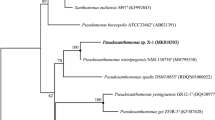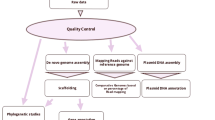Abstract
A fusant strain F14 with high biodegradation capability of phenanthrene was obtained by protoplast fusion between Sphingomonas sp. GY2B (GenBank DQ139343) and Pseudomonas sp. GP3A (GenBank EU233280). F14 was screened and identified from 39 random fusants by antibiotic tests, scanning electron microscope (SEM) and randomly amplified polymorphic DNA (RAPD). The result of SEM analysis demonstrated that the cell shape of fusant F14 different from parental strains. RAPD analysis of 5 primers generated a total of 70 bands. The genetic similarity indices between F14 and parental strains GY2B and GP3A were 27.9 and 34.6 %, respectively. F14 could rapidly degrade phenanthrene within 24 h, and the degradation efficiency was much better than GY2B and GP3A. GC–MS analysis of metabolites of phenanthrene degradation indicated F14 had a different degradation pathway from GY2B. Furthermore, the fusant strain F14 had a wider adaptation of temperatures (25–36 °C) and pH values (6.5–9.0) than GY2B. The present study indicated that fusant strain F14 could be an effective and environment-friendly bacterial strain for PAHs bioremediation.






Similar content being viewed by others
References
Beltrametti F, Barucco D, Rossi R, Selva E, Marinelli F (2007) Protoplast fusion and gene recombination in the uncommon actinomycete Planobispora rosea producing ge2270. J Antibiot 60:447–454
Carney MW, Erwin K, Hardman R, Yuen B, Volz DC, Hinton DE, Kullman SW (2008) Differential developmental toxicity of naphthoic acid isomers in medaka (Oryzias latipes) embryos. Mar Pollut Bull 57:255–266
Chakraborty U, Sikdar SR (2008) Production and characterization of somatic hybrids raised through protoplast fusion between edible mushroom strains Volvariella volvacea and Pleurotus florida. World J Microbiol Biotechnol 24:1481–1492
Chen XP, Yi XY, Tao XQ, Wu RR, Yang C, Dang Z (2008) Screening and characterization of pyrene-degrading microbial. Chin J Environ Eng 3:413–417
Ghosal D, Chakraborty J, Khara P, Dutta TK (2010) Degradation of phenanthrene via meta-cleavage of 2-hydroxy-1-naphthoic acid by Ochrobactrum sp. strain PWTJD. FEMS Microbiol Lett 313:103–110
Guo C, Zhou H, Wong Y, Tam N (2005) Isolation of PAH-degrading bacteria from mangrove sediments and their biodegradation potential. Mar Pollut Bull 51:1054–1061
Jacques RJS, Santos EC, Bento FM, Peralba MCR, Selbach PA, Sá ELS, Camargo FAO (2005) Anthracene biodegradation by Pseudomonas sp. isolated from a petrochemical sludge landfarming site. Int Biodeterior Biodegradation 56:143–150
Janbandhu A, Fulekar M (2011) Biodegradation of phenanthrene using adapted microbial consortium isolated from petrochemical contaminated environment. J Hazard Mater 187:333–340
John RP, Gangadharan D, Madhavan Nampoothiri K (2008) Genome shuffling of Lactobacillus delbrueckii mutant and Bacillus amyloliquefaciens through protoplasmic fusion for L-lactic acid production from starchy wastes. Bioresour Technol 99:8008–8015
Kawa-Rygielska J (2004) Obtaining hybrids of distillery yeasts characterized by the ability of ferementing starch. Biotechnology 7:2
Kim TJ, Lee EY, Kim YJ, Cho KS, Ryu HW (2003) Degradation of polyaromatic hydrocarbons by Burkholderia cepacia 2A–12. World J Microbiol Biotechnol 24(19):411–417
Kiyohara H, Nagao K, Yana K (1982) Rapid screen for bacteria degrading water-insoluble, solid hydrocarbons on agar plates. Appl Environ Microbiol 43:454–457
Lu J, Dang Z, Lu GN, Yang C, Yi XY, Guo CL (2012) Biodegradation kinetics of phenanthrene by a fusant strain. Curr Microbiol 65:225–230
Mallick S, Dutta TK (2008) Kinetics of phenanthrene degradation by Staphylococcus sp. Strain PN/Y involving 2-hydroxy-1-naphthoic acid in a novel metabolic pathway. Process Biochem 43:1004–1008
Mallick S, Chatterjee S, Dutta TK (2007) A novel degradation pathway in the assimilation of phenanthrene by Staphylococcus sp. strain PN/Y via meta-cleavage of 2-hydroxy-1-naphthoic acid: formation of trans-2, 3-dioxo-5-(2′-hydroxyphenyl)-pent-4-enoic acid. Microbiology 153:2104–2115
Moody JD, Freeman JP, Doerge DR, Cerniglia CE (2001) Degradation of phenanthrene and anthracene by cell suspensions of Mycobacterium sp. strain PYR-1. Appl Environ Microbiol 67:1476
Parikh SJ, Chorover J, Burgos WD (2004) Interaction of phenanthrene and its primary metabolite (1-hydroxy-2-naphthoic acid) with estuarine sediments and humic fractions. J Contam Hydrol 72:1–22
Pasha C, Kuhad R, Rao LV (2007) Strain improvement of thermotolerant Saccharomyces cerevisiae VS3 strain for better utilization of lignocellulosic substrates. J Appl Microbiol 103:1480–1489
Peng RH, Xiong AS, Xue Y, Fu XY, Gao F, Zhao W, Tian YS, Yao QH (2008) Microbial biodegradation of polyaromatic hydrocarbons. FEMS Microbiol Rev 32:927–955
Pinyakong O, Habe H, Supaka N, Pinpanichkarn P, Juntongjin K, Yoshida T, Furihata K, Nojiri H, Yamane H, Omori T (2000) Identification of novel metabolites in the degradation of phenanthrene by Sphingomonas sp. strain P2. FEMS Microbiol Lett 191:115–121
Reddy MS, Naresh B, Leela T, Prashanthi M, Madhusudhan NC, Dhanasri G, Devi P (2010) Biodegradation of phenanthrene with biosurfactant production by a new strain of Brevibacillus sp. Bioresour Technol 101:7980–7983
Romero M, Cazau M, Giorgieri S, Arambarri A (1998) Phenanthrene degradation by microorganisms isolated from a contaminated stream. Environ Pollut 101:355–359
Samanta SK, Singh OV, Jain RK (2002) Polycyclic aromatic hydrocarbons: environmental pollution and bioremediation. Trends Biotechnol 20:243–248
Seo JS, Keum YS, Hu Y, Lee SE, Li QX (2006) Phenanthrene degradation in Arthrobacter sp. P1–1: initial 1, 2-, 3, 4- and 9, 10-dioxygenation, and meta- and ortho-cleavages of naphthalene-1, 2-diol after its formation from naphthalene-1, 2-dicarboxylic acid and hydroxyl naphthoic acids. Chemosphere 65:2388–2394
Seo JS, Keum YS, Hu Y, Lee SE, Li QX (2007) Degradation of phenanthrene by Burkholderia sp. C3: initial 1, 2- and 3, 4-dioxygenation and meta- and ortho-cleavage of naphthalene-1, 2-diol. Biodegradation 18:123–131
Tam N, Guo C, Yau W, Wong Y (2002) Preliminary study on biodegradation of phenanthrene by bacteria isolated from mangrove sediments in Hong Kong. Mar Pollut Bull 45:316–324
Tao XQ, Lu GN, Yi XY, Dang Z (2006) Isolation of phenanthrene-degrading microorganisms and analysis of metabolites of phenanthrene. J Agro-Environ Sci 25:190–195
Tao XQ, Lu GN, Dang Z, Yang C, Yi XY (2007) A phenanthrene-degrading strain Sphingomonas sp. GY2B isolated from contaminated soils. Process Biochem 42:401–408
Tian L, Ma P, Zhong JJ (2002) Kinetics and key enzyme activities of phenanthrene degradation by Pseudomonas mendocina. Process Biochem 37:1431–1437
Ting W, Yuan S, Wu S, Chang B (2011) Biodegradation of phenanthrene and pyrene by ganoderma lucidum. Int Biodeterior Biodegradation 65:238–242
Tiwari JN, Reddy MMK, Patel DK, Jain SK, Murthy RC, Manickam N (2010) Isolation of pyrene degrading achromobacter xylooxidans and characterization of metabolic product. World J Microbiol Biotechnol 26:1727–1733
Wong JWC, Fang M, Zhao Z, Xing B (2004) Effect of surfactants on solubilization and degradation of phenanthrene under thermophilic conditions. J Environ Qual 33:2015–2025
Xue W, Warshawsky D (2005) Metabolic activation of polycyclic and heterocyclic aromatic hydrocarbons and DNA damage: a review. Toxicol Appl Pharmacol 206:73–93
Zhao HP, Wu QS, Wang L, Zhao XT, Gao HW (2009) Degradation of phenanthrene by bacterial strain isolated from soil in oil refinery fields in shanghai china. J Hazard Mater 164:863–869
Acknowledgments
This study was supported by grants from the National Natural Science Foundation of China (No. 41101291 and 21007017), the Guangdong Provincial Natural Science Foundation (9351064101000001, S2012040007463 and S2012010008589), the Open Foundation of the Key Laboratory of Water and Air Pollution Control of Guangdong Province (2011A060901002), and the Science and Technology Planning Project of Guangzhou City (12C62081569).
Author information
Authors and Affiliations
Corresponding author
Rights and permissions
About this article
Cite this article
Lu, J., Guo, C., Li, J. et al. A fusant of Sphingomonas sp. GY2B and Pseudomonas sp. GP3A with high capacity of degrading phenanthrene. World J Microbiol Biotechnol 29, 1685–1694 (2013). https://doi.org/10.1007/s11274-013-1331-3
Received:
Accepted:
Published:
Issue Date:
DOI: https://doi.org/10.1007/s11274-013-1331-3




